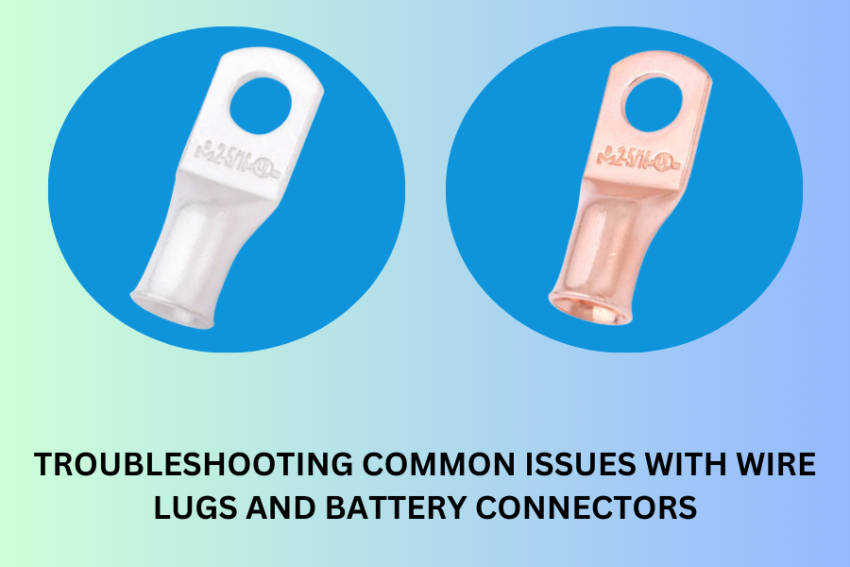Wire lugs and battery connectors are crucial components in electrical systems, ensuring a stable and reliable connection for the flow of electricity. However, like any electrical component, they can encounter issues that affect performance and safety. This article will explore common problems with wire lugs and battery connectors, offering practical troubleshooting tips to ensure optimal functionality.
1. Corrosion and Oxidation
Symptoms: Diminished electrical conductivity, increased resistance, and visible discoloration.
Causes: Corrosion and oxidation occur when metal connectors are exposed to moisture and air. This is especially common in marine environments or areas with high humidity.
Troubleshooting Tips:
- Regular Inspection: Routinely check connectors for signs of corrosion. Look for discoloration or a powdery residue on the surface.
- Cleaning: Use a wire brush or sandpaper to remove corrosion. For severe cases, a solution of baking soda and water can neutralize acidic corrosion.
- Protective Coatings: Apply anti-corrosion sprays or dielectric grease to protect connectors from future exposure to moisture.
2. Loose Connections
Symptoms: Intermittent power supply, sparking, and overheating.
Causes: Loose connections can result from improper installation, vibration, or thermal expansion and contraction.
Troubleshooting Tips:
- Proper Installation: Ensure connectors are properly crimped or soldered during installation. Use the right size and type of wire lug for the application.
- Tightening: Regularly check and tighten connections. Use a torque wrench to ensure connectors are tightened to the manufacturer’s specifications.
- Vibration Dampening: In high-vibration environments, use vibration dampeners or lock washers to maintain secure connections.
3. Overheating
Symptoms: Melted insulation, discolored wire lugs, and burnt smells.
Causes: Overheating can be caused by high resistance due to corrosion or loose connections, excessive current flow, or inadequate conductor size.
Troubleshooting Tips:
- Proper Sizing: Ensure wire lugs and connectors are rated for the current they will carry. Using undersized connectors can lead to overheating.
- Cooling: Provide adequate ventilation around connectors to dissipate heat. In high-current applications, consider using heat sinks.
- Monitoring: Use thermal imaging cameras to identify hotspots in electrical systems and address overheating issues promptly.
4. Cracking and Mechanical Damage
Symptoms: Visible cracks, broken connectors, and exposed conductors.
Causes: Mechanical damage can result from improper handling, excessive tightening, or impact during installation or maintenance.
Troubleshooting Tips:
- Careful Handling: Handle Heavy Duty Wire Lugs and connectors with care. Avoid dropping or striking them against hard surfaces.
- Correct Tools: Use appropriate tools for installation and maintenance. Avoid using tools that may exert excessive force on the connectors.
- Inspection: Regularly inspect connectors for signs of mechanical damage and replace any damaged components immediately.
5. Poor Crimping or Soldering
Symptoms: Loose or intermittent connections, high resistance, and failure of the electrical connection.
Causes: Improper crimping or soldering techniques can result in inadequate mechanical and electrical connections.
Troubleshooting Tips:
- Quality Tools: Use high-quality crimping tools designed for the specific type of wire lug and conductor. Avoid using pliers or other makeshift tools.
- Training: Ensure personnel are properly trained in crimping and soldering techniques. Consider periodic refresher training to maintain high standards.
- Inspection: After crimping or soldering, inspect connections for completeness and strength. Tug on the wire to ensure it is securely attached to the lug.
6. Incompatible Materials
Symptoms: Galvanic corrosion, reduced conductivity, and weakened connections.
Causes: Using incompatible materials, such as connecting aluminum wire to copper cable lugs without proper treatment, can lead to galvanic corrosion.
Troubleshooting Tips:
- Material Matching: Ensure that the materials of the wire and connectors are compatible. Use connectors specifically designed for the wire type being used.
- Barrier Coatings: Apply anti-oxidant compounds to aluminum conductors before connecting to copper lugs to prevent galvanic corrosion.
- Bimetallic Connectors: In cases where different metals must be joined, use bimetallic connectors designed to safely connect dissimilar metals.
7. Environmental Factors
Symptoms: Accelerated wear, corrosion, and reduced lifespan of connectors.
Causes: Harsh environmental conditions, such as extreme temperatures, saltwater exposure, and chemical exposure, can degrade connectors.
Troubleshooting Tips:
- Environmental Protection: Use connectors rated for the specific environmental conditions they will face. For marine applications, choose connectors with marine-grade ratings.
- Sealing and Enclosures: Use sealed connectors or enclosures to protect against environmental exposure. Waterproof and dustproof connectors can extend the lifespan of the components.
- Regular Maintenance: Perform regular maintenance checks and cleanings to mitigate the effects of environmental exposure.
Conclusion
Proper installation, regular maintenance, and timely troubleshooting of Heavy Duty Wire Lugs and battery connectors are essential for maintaining the reliability and safety of electrical systems. By addressing common issues such as corrosion, loose connections, overheating, and mechanical damage, you can ensure that your electrical connections remain robust and efficient. Implementing these troubleshooting tips will help you identify and rectify problems before they lead to significant failures, enhancing the overall performance and longevity of your electrical systems.

